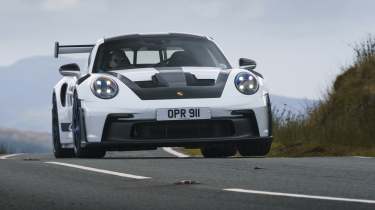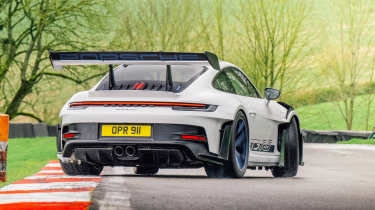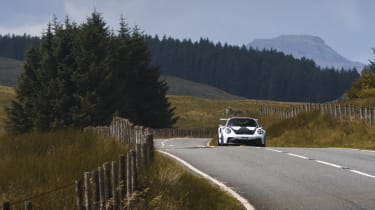Porsche 911 GT3 RS – ride and handling
The RS has phenomenal breadth, precision and ability on everything from wet B-roads to Cadwell Park
The RS was designed for the track, but the real world is littered with bumps. And catseyes. And crappy road repairs. The 275-section front tyres get hooked into all sorts of grooves and cambers and even within the Normal mode’s operating window the ride is disjointed and busy. The car’s structure feels rock-solid and the rose-jointed suspension never knocks, creaks or rattles, but at low and medium speeds there’s a physical, knuckly feeling to the way the RS gets down a road. Not so much limbering-up as cracking joints in preparation for what lies ahead.
The whole car feels like it’s waiting for more speed and more positivity. The steering is unbelievably responsive; the solid brake pedal is accurate even with gentle inputs, but you sense there’s massive power just waiting to be deployed (amazingly, the carbon-ceramic discs fitted to this car are a cost option); there’s a latent energy that almost demands to be unleashed.
Track mode is pretty much the only mode you’ll ever want. Just as with the GT3 and GT4 RS, stiffer settings seem to settle the whole car down. From bobbly and slightly ill-at-ease, the ride becomes so much more decisive. It’s not supple in the way of a McLaren or Ferrari, but the platform feels so stable and it deals with all but the very worst surfaces with instantaneous efficiency, leaving you to just focus on unpicking the road and unleashing the engine.
It’s a fascinating and sometimes quite surreal experience. In many ways the seeds of the traditional 911 experience are completely gone. On the road at least, this is not a car that requires a unique driving style to exploit. No concessions are required for the peculiar engine position. The RS turns in with startling speed and accuracy. It takes your breath away. Now layer on top the mechanical grip of a chassis with huge roll stiffness that still squeezes the massive tyres into the surface, plus the rear engine’s natural advantages in terms of traction and the result is nothing short of outrageous. Corners no longer have ‘phases’. The RS allows you to overlap turn-in and throttle application to the extent that even roads you know well become brand new. It plays by a different set of rules.
More reviews
Group tests
In-depth reviews
- Porsche 911 review 2025 – Gen2 992 is the 911 for the digital age
- Used Porsche 911 (991, 2011 - 2018) review – should you buy the unloved 911?
Long term tests
Reviews
So the 992 GT3 RS requires a mental reset. The thrill comes from carrying speed, from opening up the engine early and living at high revs, from having the chassis fully loaded and being dazzled by the immense turn-in stability, the wonderful, neutral balance and the sheer agility it demonstrates. In itself that’s a bigger thrill than reining a car in all the time, but on the road it does make the RS a curious proposition. To really enjoy its capabilities requires a level of commitment that’s uncomfortable in all but the most remote and empty locations.
Luckily there’s much to enjoy at lower speeds, too. The tactile sensation of the titanium paddles with their new, heavier magnetic action, the precise throttle mapping, that immensely satisfying steering response and the overwhelming impression that you’re in something that elevates the mundane into something heroic. The rear wing flattening off as the DRS activates in three-tenths of a second should feel a bit silly, for example, but actually it’s oddly cool and exciting. If you couldn’t feel the added aero-enabled stability as speeds rise it would be a nonsense, but the RS is one of very few cars where you can start to feel the downforce work in quicker turns. There’s a wonderful authenticity to the whole experience.
What about the suspension adjustment that could so easily slip into the realms of gimmick? It’s fabulous. The on-the-fly adjustment genuinely creates a greater sense of depth and it’s really enjoyable to play around with different settings and feel how they affect the car’s dynamic responses. Experimenting with the lock-up characteristics of the rear e-diff is also particularly satisfying and allows you to start bringing the rear of the car into play, too, should you want that slightly more rear-led feel that a 911 fan can’t help but crave.
There are new dimensions to explore here. The old cliché about 911s was that owners would continue to learn and explore their many dynamic facets over a long period. It’s why they’ve always held such a fascination. In recent years and with each subsequent generation – particularly since the 991 arrived – this notion has been eroded as the rear-engined foibles have been polished away. The 992 GT3 RS takes this to extremes. In many ways, it’s not a 911 experience at all.
But by allowing so much mechanical configurability (and this is the key: mechanical) in such a simple, intuitive way, the driver can find a new level of engagement and start a new and deeply fulfilling relationship. Sounds corny, but then it always did, right? The 992 GT3 RS is an aero-monster. But it’s a fascinating, multi-dimensional and highly enjoyable road car, too.





